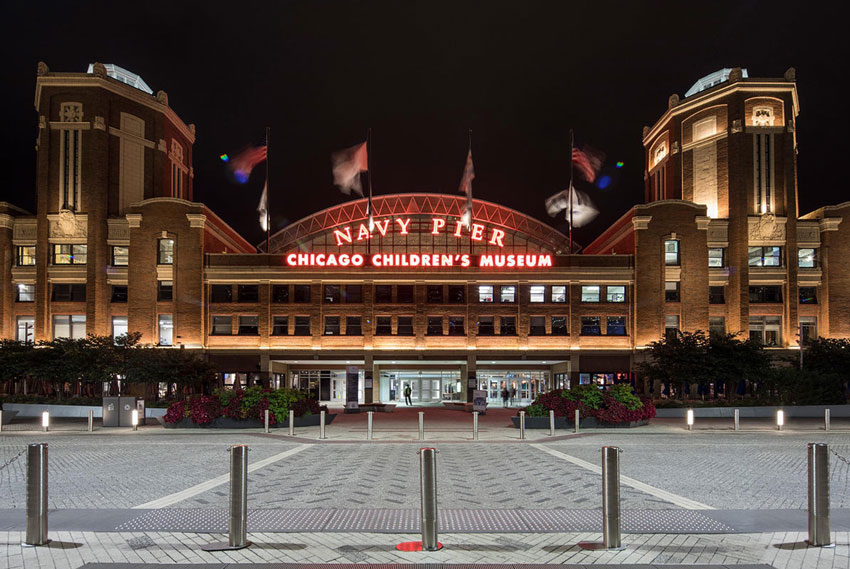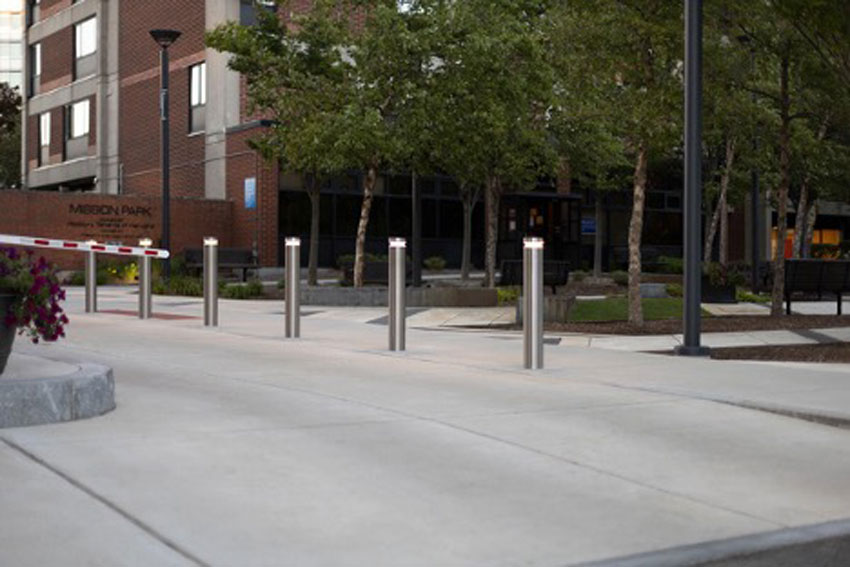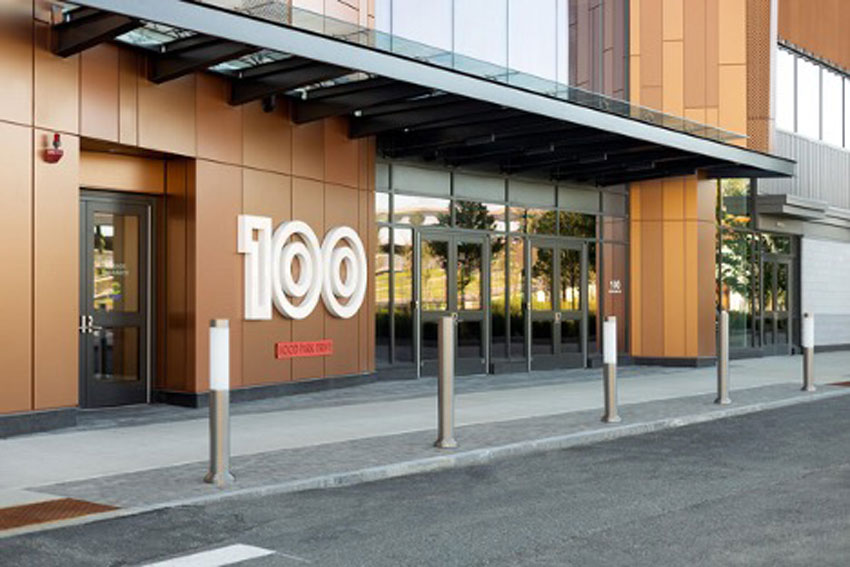This CE Center article is no longer eligible for receiving credits.
Site security is a major concern in today’s unpredictable world. Public and private buildings, government facilities, campuses, and public parks are all susceptible to accidental as well as deliberate vehicle infringement. Design professionals, city planners, facilities managers, and engineers must now be increasingly sensitive to the safety and security requirements of public and private spaces, and balancing these concerns with a site’s aesthetic criteria.
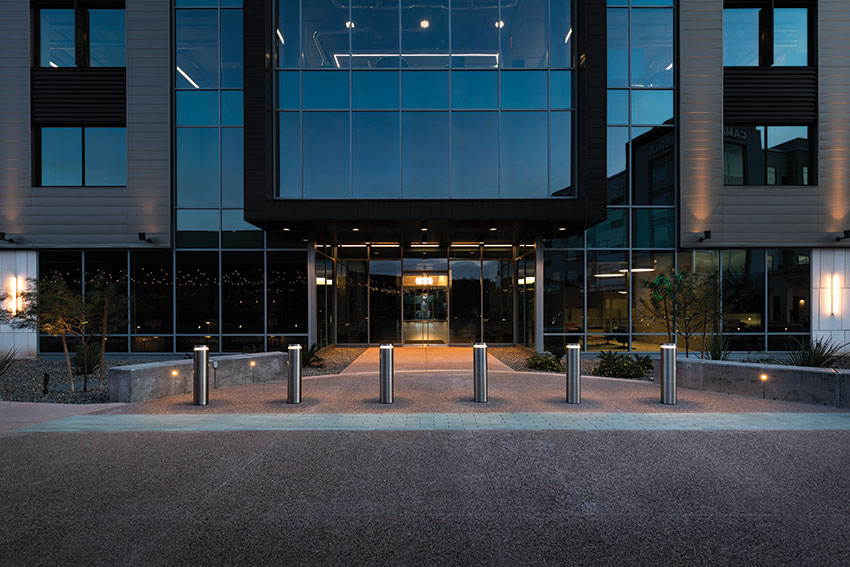
Photo courtesy of Forms+Surfaces
The requirements of site security and safety increasingly govern the design of today’s most visible commercial and public spaces. New advancements in security bollard manufacturing allow for creation of a secure perimeter while preserving the desired design aesthetic.
SPECIFYING SAFE SOLUTIONS FOR AN UNPREDICTABLE WORLD
There are many ways in which to create safeguards for structures and people while maintaining a standoff distance for vehicles. Barriers or devices used to prevent vehicle ingress are referred to as vehicle security barriers. Bollards are one of the most commonly used vehicle security barriers. A bollard refers to a constructed post used to demarcate an architectural or protective perimeter. Bollards can be specified with almost any material, with the most common manufacture being from metal, stone, cement, or plastic. Traditionally, bollard material and style have been defined by their function. Now, designers are finding a wider variety of shapes and styles to accentuate or complement the desired design aesthetic.
“We’ve seen demand for rated security bollards skyrocket in recent years, to the point that they are quickly becoming some of our highest selling outdoor products. Our team of designers and engineers have been working to bring new innovations to the market to support this demand,” notes Ryan Seiler, Engineering and Design, Forms+Surfaces.
Today’s built environment features bollards in almost every application imaginable. Design professionals incorporate bollards to manage pedestrian and vehicle flow, to enhance exterior design, as wayfinding and lighting for pathways, to secure and protect buildings and people, and even to provide bike parking. Bollards can also be found indoors, creating perimeters. For example, bollards are employed in warehouses to prevent damage to structures or utilities by machinery, or in entrance lobbies, creating better flow and more clearly defined spaces.
Security bollards placed at points of ingress are an excellent way to guard against vehicle infringement while still allowing for pedestrian access. Security bollards act as both a physical and visual barrier. They are varied in their shapes, sizes, and designs. Bollards and security barriers protect lives and property by creating a controlled traffic setting. Knowing the differences between types of bollards helps the engineer and design professional to select the best solution for a site.
What Makes Up a Security Bollard?
Until recently, security bollards have frequently taken the form of generic pipes or cylinders that offer little in the way of design or lighting functionality. Design enhancements now provide a solution that blends security, performance, and style. By adding a pre-engineered security core, leading manufacturers are responding to the demand for functional designs that combine lighting performance and high durability materials. The needs of today's public spaces can be met with beautiful, illuminated bollards that meet stringent high-impact crash requirements, or bollards designed to seamlessly integrate into an existing landscape. Additionally, modern security bollards provide highly customizable solutions that fit various types of installations—retractable, removable, and custom foundation engineered bollards.
security bollard is often composed of three distinct parts: its foundation, core, and sleeve. The core is set in its foundation, per specification, and the combination of these two elements give the bollard its strength. In many designs a sleeve is also then mounted over the core. It is the bollard sleeve that forms the most visible part of the product and can be used to enhance the landscape and building design.
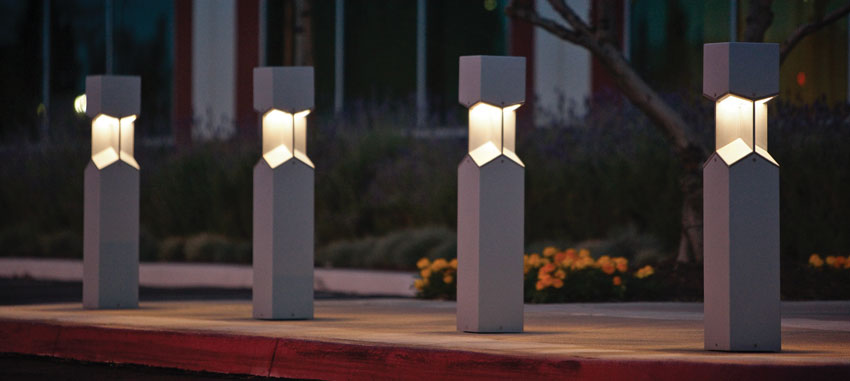
Photo courtesy of Forms+Surfaces
The needs of today's public spaces can be met with beautiful, illuminated bollards that meet stringent high-impact crash requirements or bollards designed to seamlessly integrate into an existing landscape.
Evaluating a Project’s Security Needs
With the growing necessity for site safety, security bollards are not only in demand, but they also are facing increasingly stringent standards. By necessity, older fixtures are being replaced with newer models that stand up to enhanced requirements.
Security bollards are often used to restrict movement of vehicles into perimeters where pedestrians and infrastructure may be exposed to certain specified hazards, such as terrorist attacks or vehicles used for ram raids. The effectiveness of vehicle anti-ram bollards is dependent on their ability to resist the energy from the impact. The U.S. Department of State, Guide to Active Vehicle Barrier (AVB) Specification and Selection Resources (2003), specifies criteria to help engineers, design professionals, and building owners select a barrier for use at facilities. The Department of State rating is based on type of impact. This selection is done based on crash-rated barriers or engineer-rated systems. Specification for bollards considers the speed and the mass of the approaching vehicle, as well as the distance it travels after impact. While the guide focuses on Level 1 or Level 2 Facilities, the decision matrix discussed is useful for many projects.
Beyond specifying bollards for Level 1 or 2 facilities, a designer may want to consider an assessment of the threat level for their project. The needs of a site will likely fall into three categories: low, medium, or high security needs.
A building with low security needs may be an office building with low pedestrian activity. Bollards for these lower threat perimeters are designed to stop passenger cars and direct traffic that might accidentally come into the building’s path. Typical applications include store fronts and pedestrian pathways that front parking or low speed traffic activity.
Buildings that face a more moderate threat to security are those whose site or location may allow vehicles to pick up some speed, traveling at up to 30 miles per hour (mph). These areas may also contain high value properties or host large public gatherings.
Buildings and areas that face a greater security threat and need high-threat solutions, include federal buildings, high-value properties, and areas, both outdoor and indoor, designed for hospitality and public events. This includes government buildings and pedestrian corridors. These buildings may also be near major roadways or areas that could face ingress from a larger vehicle traveling at high speeds.
Conducting a Security Assessment
An initial security review can include assessments of perceived threats, an analysis of the project’s site, an understanding of the consequences of compromise, and highlighting perceived vulnerabilities. The structure, roads, terrain, and landscaping all combine to impact the security of the site. The placement of exits and entrances, and locations of critical infrastructure, should also be reviewed.
Whole life-cycle planning also helps to inform the specification and selection of security measures, including bollards. The cost, not only to acquire, but also to install, maintain, refurbish, and replace a product, needs to be evaluated. The selected bollard should fit the site design and address the threat; its installation, operation, and maintenance should also not burden operations.
Finally, design professionals may also want to consider bollards that are non-crash resistant or non-rated as a supplement in their security plan. Non-crash-resistant bollards provide a visual barrier, direct traffic, provide enough space for pedestrians, and can be chosen as a deterrent. They can be used by themselves or be worked into a larger security plan. Engaging bollards with lighting to create a unified design and perimeter not only bolsters the safety of a site, but can assist with wayfinding, signaling to vehicles and pedestrian where to travel and adding to the branded identity of a site. Finding a product family that offers a variety of options also creates a cohesive look across a project. Additional elements that can enhance a security design include pathway lighting and pedestrian lighting.
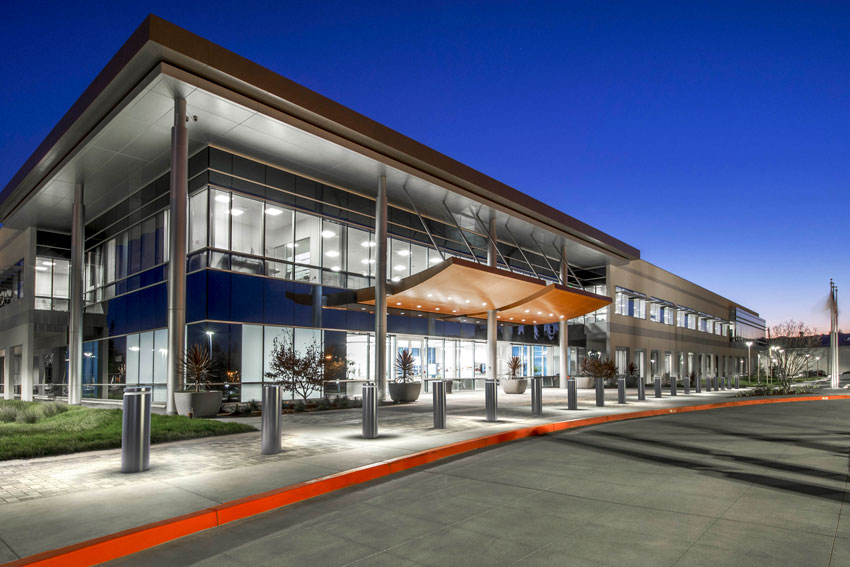
Photo courtesy of Forms+Surfaces
Modern security bollards provide highly customizable solutions that fit various types of installations and security needs.
Site security is a major concern in today’s unpredictable world. Public and private buildings, government facilities, campuses, and public parks are all susceptible to accidental as well as deliberate vehicle infringement. Design professionals, city planners, facilities managers, and engineers must now be increasingly sensitive to the safety and security requirements of public and private spaces, and balancing these concerns with a site’s aesthetic criteria.

Photo courtesy of Forms+Surfaces
The requirements of site security and safety increasingly govern the design of today’s most visible commercial and public spaces. New advancements in security bollard manufacturing allow for creation of a secure perimeter while preserving the desired design aesthetic.
SPECIFYING SAFE SOLUTIONS FOR AN UNPREDICTABLE WORLD
There are many ways in which to create safeguards for structures and people while maintaining a standoff distance for vehicles. Barriers or devices used to prevent vehicle ingress are referred to as vehicle security barriers. Bollards are one of the most commonly used vehicle security barriers. A bollard refers to a constructed post used to demarcate an architectural or protective perimeter. Bollards can be specified with almost any material, with the most common manufacture being from metal, stone, cement, or plastic. Traditionally, bollard material and style have been defined by their function. Now, designers are finding a wider variety of shapes and styles to accentuate or complement the desired design aesthetic.
“We’ve seen demand for rated security bollards skyrocket in recent years, to the point that they are quickly becoming some of our highest selling outdoor products. Our team of designers and engineers have been working to bring new innovations to the market to support this demand,” notes Ryan Seiler, Engineering and Design, Forms+Surfaces.
Today’s built environment features bollards in almost every application imaginable. Design professionals incorporate bollards to manage pedestrian and vehicle flow, to enhance exterior design, as wayfinding and lighting for pathways, to secure and protect buildings and people, and even to provide bike parking. Bollards can also be found indoors, creating perimeters. For example, bollards are employed in warehouses to prevent damage to structures or utilities by machinery, or in entrance lobbies, creating better flow and more clearly defined spaces.
Security bollards placed at points of ingress are an excellent way to guard against vehicle infringement while still allowing for pedestrian access. Security bollards act as both a physical and visual barrier. They are varied in their shapes, sizes, and designs. Bollards and security barriers protect lives and property by creating a controlled traffic setting. Knowing the differences between types of bollards helps the engineer and design professional to select the best solution for a site.
What Makes Up a Security Bollard?
Until recently, security bollards have frequently taken the form of generic pipes or cylinders that offer little in the way of design or lighting functionality. Design enhancements now provide a solution that blends security, performance, and style. By adding a pre-engineered security core, leading manufacturers are responding to the demand for functional designs that combine lighting performance and high durability materials. The needs of today's public spaces can be met with beautiful, illuminated bollards that meet stringent high-impact crash requirements, or bollards designed to seamlessly integrate into an existing landscape. Additionally, modern security bollards provide highly customizable solutions that fit various types of installations—retractable, removable, and custom foundation engineered bollards.
security bollard is often composed of three distinct parts: its foundation, core, and sleeve. The core is set in its foundation, per specification, and the combination of these two elements give the bollard its strength. In many designs a sleeve is also then mounted over the core. It is the bollard sleeve that forms the most visible part of the product and can be used to enhance the landscape and building design.

Photo courtesy of Forms+Surfaces
The needs of today's public spaces can be met with beautiful, illuminated bollards that meet stringent high-impact crash requirements or bollards designed to seamlessly integrate into an existing landscape.
Evaluating a Project’s Security Needs
With the growing necessity for site safety, security bollards are not only in demand, but they also are facing increasingly stringent standards. By necessity, older fixtures are being replaced with newer models that stand up to enhanced requirements.
Security bollards are often used to restrict movement of vehicles into perimeters where pedestrians and infrastructure may be exposed to certain specified hazards, such as terrorist attacks or vehicles used for ram raids. The effectiveness of vehicle anti-ram bollards is dependent on their ability to resist the energy from the impact. The U.S. Department of State, Guide to Active Vehicle Barrier (AVB) Specification and Selection Resources (2003), specifies criteria to help engineers, design professionals, and building owners select a barrier for use at facilities. The Department of State rating is based on type of impact. This selection is done based on crash-rated barriers or engineer-rated systems. Specification for bollards considers the speed and the mass of the approaching vehicle, as well as the distance it travels after impact. While the guide focuses on Level 1 or Level 2 Facilities, the decision matrix discussed is useful for many projects.
Beyond specifying bollards for Level 1 or 2 facilities, a designer may want to consider an assessment of the threat level for their project. The needs of a site will likely fall into three categories: low, medium, or high security needs.
A building with low security needs may be an office building with low pedestrian activity. Bollards for these lower threat perimeters are designed to stop passenger cars and direct traffic that might accidentally come into the building’s path. Typical applications include store fronts and pedestrian pathways that front parking or low speed traffic activity.
Buildings that face a more moderate threat to security are those whose site or location may allow vehicles to pick up some speed, traveling at up to 30 miles per hour (mph). These areas may also contain high value properties or host large public gatherings.
Buildings and areas that face a greater security threat and need high-threat solutions, include federal buildings, high-value properties, and areas, both outdoor and indoor, designed for hospitality and public events. This includes government buildings and pedestrian corridors. These buildings may also be near major roadways or areas that could face ingress from a larger vehicle traveling at high speeds.
Conducting a Security Assessment
An initial security review can include assessments of perceived threats, an analysis of the project’s site, an understanding of the consequences of compromise, and highlighting perceived vulnerabilities. The structure, roads, terrain, and landscaping all combine to impact the security of the site. The placement of exits and entrances, and locations of critical infrastructure, should also be reviewed.
Whole life-cycle planning also helps to inform the specification and selection of security measures, including bollards. The cost, not only to acquire, but also to install, maintain, refurbish, and replace a product, needs to be evaluated. The selected bollard should fit the site design and address the threat; its installation, operation, and maintenance should also not burden operations.
Finally, design professionals may also want to consider bollards that are non-crash resistant or non-rated as a supplement in their security plan. Non-crash-resistant bollards provide a visual barrier, direct traffic, provide enough space for pedestrians, and can be chosen as a deterrent. They can be used by themselves or be worked into a larger security plan. Engaging bollards with lighting to create a unified design and perimeter not only bolsters the safety of a site, but can assist with wayfinding, signaling to vehicles and pedestrian where to travel and adding to the branded identity of a site. Finding a product family that offers a variety of options also creates a cohesive look across a project. Additional elements that can enhance a security design include pathway lighting and pedestrian lighting.

Photo courtesy of Forms+Surfaces
Modern security bollards provide highly customizable solutions that fit various types of installations and security needs.
TESTING FOR CONFIDENCE
When selecting a product to provide security, confidence in its performance is a must. A security bollard barrier system must be robust enough to resist impact from a vehicle with a specified weight and approach speed. Bollards that are built to meet standards provide confidence that a product will provide the proper level of resistance. Certification enables the design professional to make an informed, safe decision for their project and to protect a property owner against future risk of litigation.
Common Testing Standards
It is important to find the product that meets the standard most relevant to a project’s needs. Simply because a product meets a certification standard, that product does not necessarily provide the appropriate aesthetic and characteristics for a project. There are many different ratings systems and specification standards for bollards. However, there are typically three main variables that make up the rating: vehicle classification (size and weight), vehicle speed, and penetration distance.
The U.S. Department of State released the first vehicle barrier certification standard in 1985. This certification, known as a “K” rating, is a crash test certification issued by the Department of State to a fence, gate, barrier, or bollard. K-rated bollards are often referred to as ram, anti-ram, or anti-terrorism bollards. The rating describes the perpendicular impact penetration of a vehicle of a specific weight at a specific speed. The K-rating weight of the vehicle is standardized at 15,000 lbs. and can be compared in size to a box truck.
In 2003, the Department of State criteria was enhanced so that any barrier earning a K rating can only allow the truck to penetrate no further than 36 inches past the leading edge of the bed. A barrier with a K4 rating states that the bollard, in testing conditions, stopped a 15,000-lb. vehicle traveling at 30 mph within 36 inches or less. A barrier earning a K8 rating stops the same vehicle traveling at 40 mph and a barrier earning a K12 rating stops the 15,000-lb. vehicle traveling 50 mph in less than 36 inches.
The Department of State K ratings were superseded in 2007 by the introduction of American Society for Testing and Materials (ASTM) F2656. Today, the two most commonly used assessments in the United States are the American Society for Testing and Materials (ASTM) F2656/F2656M-20 and (ASTM) F3016/F3016M-19.
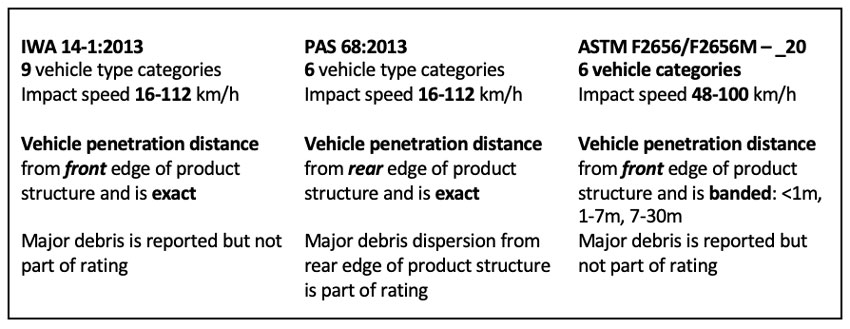
Photo courtesy of Forms+Surfaces
UK and European standards have been developed using test vehicles commonly found on UK and European roads, whereas the American standard is relevant to vehicles typical on its domestic roads. Vehicle shape is the most apparent difference between commercial vehicles and has a bearing on its construction, including chassis rail design and height; positions of axle, engine block, and load bed.1
ASTM F2656
Various standards are used to assess the vehicle impact performance of vehicle security barrier (VSB). ASTM standards include F2656, which tests for high-speed impact, and F3016, which addresses low-speed impacts below 30 mph.
Under ASTM F2656/F2656M-20, “Standard Test Method for Crash Testing of Vehicle Security Barriers,” the target of the standard is to guard against building penetration and establish a measure of performance. This test method provides a range of vehicle impact conditions, designations, and penetration performance levels. The results and ratings allow design professionals to select passive perimeter barriers and active entry point barriers appropriate for use at facilities with a defined moving vehicle threat. Condition designations and performance levels in this test method can be adapted to meet a project’s specific needs. Many test parameters are standardized to arrive at a common vehicle type and mass, and replication, and produce uniform rating designations.
Standard vehicle conditions under ASTM F2656-20:
- (SC) Small Passenger Car 2,420 lbs (1,100 kg)
- (FS) Full-size Sedan 4,630 lbs (2,100 kg)
- PU) Pick-up Truck 5,000 lbs. (2,100kg)
- (M) Standard Test Truck 15,000 lbs. (6,800kg)
- (C7) Class C Cab over 15,873 lbs. (7,200kg)
- (H) Heavy Goods Vehicle 65,000 lbs. (29,500kg)
Standard speeds (S): range from 30 miles per hour (mph) to 60 mph.
Based on the size of the vehicle and its speed, the generated impact conditions are also assigned a dynamic penetration rating (P):
- P1 ≤ 1 meter (3.3 ft)
- P2 = 1.01 meters (3.31 ft) to 7 meters (23.0 ft)
- P3 = 7.01 meters (23.01 ft) to 30 meters (98.4 ft)
As an example, a security bollard with an M50-P1 rating would be predicted to stop a Standard Test Truck (M) of 15,000 lbs, traveling at 50 mph (50), in less than 1 meter (P1) after the truck makes initial contact with the bollard.
While the K ratings from the original Department of State standard were replaced by ASTM F2656, there are corresponding ratings: a rating of K12 is equal to M50 under ASTM F2656; K8 is equivalent to M40 and K4 is equivalent to M30.
The design professional needs to be aware that ASTM F2656-20 states that the tested product must be installed into a low cohesive compacted soil, unless specified for a site-specific installation. When the selected bollard is installed, the team should always be aware of the ground conditions and supporting foundation used for the impact test and assess whether they are comparable with their site ground conditions. Products that carry a rating, should be accompanied with approved installation instructions. Following these instructions from a vendor is paramount to achieving the specified rating.
ASTM F3016
Under ASTM F3016, “Standard Test Method for Surrogate Testing of Vehicle Impact Protective Devices at Low Speeds,” the target of this standard is to defend assets against damage on the protected side. This test method provides a range of impact speeds to be used with a 5000-lb. surrogate test vehicle. The standard establishes a range for penetration performance ratings.
Standard vehicle conditions under ASTM F3016; Small Passenger Car, 5,000 lbs.
Standard speeds (S): range from 10 miles per hour (mph) to 30 mph.
Based on the size of the vehicle and its speed, the generated impact conditions are also assigned a dynamic penetration rating (P):
- P1 ≤ .30 meters (≤1 ft)
- P2 ≤ 0.31 – 1.22 meters (1–4 ft)
- Failure ≥ 1.23 meters (≥ 4 ft)
ASTM F3016 can be applied to a broader range of security level options for projects. Security needs assessed under these criteria cover more standard incidents, such as a distracted driver taking their foot off the gas and rolling into the storefront.
International Testing Standards
While ASTM ratings are the most broadly specified ratings that a designer will come across, the method of certification may vary depending on the location of the planned installation. The International Organization for Standardization (ISO) also has a standard for measuring security bollard performance, IWA 14, the target of which is to guard against building penetration. IWA 14 specifies the essential impact performance requirement for a vehicle security barrier (VSB) and a test method for rating its performance when subjected to a single impact by a test vehicle not driven by a human being. It also includes the following optional assessments that can be carried out as part of the vehicle impact test method: pedestrian intruder access; and occupant injury. Much like the previously discussed standards, the ISO standards are tested on the basis of the security barrier’s application, including: vehicle type, mass and speed of the assessed vehicle-borne threat; its geographical application, for example, climate conditions; and, intended site conditions, such as rigid or non-rigid soil. IWA 14 can be compared with ASTM F2656, so that a bollard earning a M50-P1 rating under ASTM F2656 can earn a Bollard V/7200[N2G]/80/90:1.0 rating from the ISO. The ratings which collaborate include the following:
- M50-P1 = Bollard V/7200[N2G]/80/90:1.0
- M40-P1 = Bollard V/7200[N2G]/64/90:1.0
- M30-P1 = Bollard V/7200[N2G]/48/90:1.0
Security bollards in the United Kingdom (UK) are tested under BSI (British Standards Institute) PAS 68:2013. Testing under BSI follows different criteria, so that direct correlations between domestic ratings and BSI are not possible.
While all these standards define test methods and performance ratings for vehicle security barriers, there are some key differences.
Testing in the Digital Age: Finite Element Analysis
Security bollards are increasingly being tested using a Finite Element Analysis (FEA) by a professional engineering consultant. FEA is a software-based tool commonly employed in the automotive industry and used extensively for crash test simulations. Manufacturers can test security bollards in FEA within a very demanding set of impact criteria. Tests are able to simulate a bollard set in permanent concrete footings and struck by a vehicle at a 90-degree impact. The vehicle, speed, and product criteria can be customized to accurately create the impact simulation and assess the bollard’s ability to stop a range of vehicles under a range of conditions.
Using FEA can be very beneficial. Product testing is less costly and faster than physical testing methods. Multiple simulations of the same impact can be run to prove conformance, as opposed to physical crash testing of products, which allows for a single test only. FEA also reduces waste, as trucks, products, and site excavation are not needed for testing or analysis.
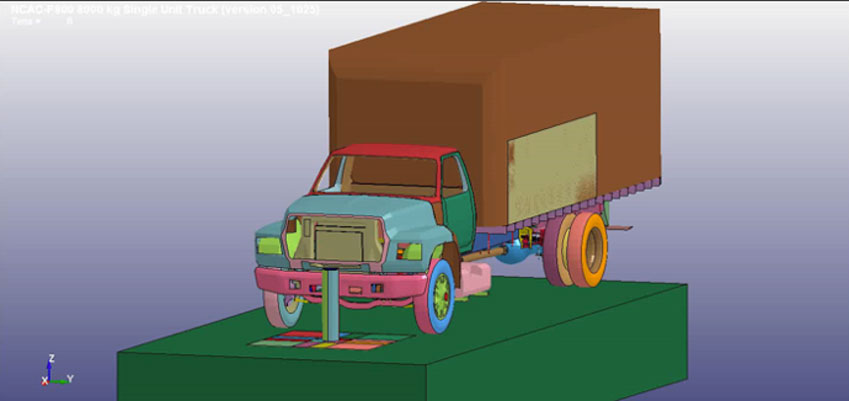
Photo courtesy of Forms+Surfaces
Finite Element Analysis (FEA) is a software-based tool that is increasingly becoming a universally accepted way of determining bollard performance.
WHAT LIES BENEATH: FOUNDATION ENGINEERING PROVIDES THE GROUNDWORK FOR TRUE SECURITY
A bollard’s crash penetration testing performance, under any standard, is about how well the bollard keeps the load carried in a vehicle away from the building, pedestrian area, or perimeter. A security bollard forms a barrier system used to restrict movement of vehicles around buildings. Most critical to this impact resistance of the bollard is its foundation.
Most security bollards are comprised of three parts: the exterior or decorative bollard sleeve, its security core, and the associated bollard foundation. While the security core’s performance is the element measured in testing, that performance is supported and provided by the foundation. In order to provide adequate protection, security cores must be paired with an appropriate and approved engineered foundation.
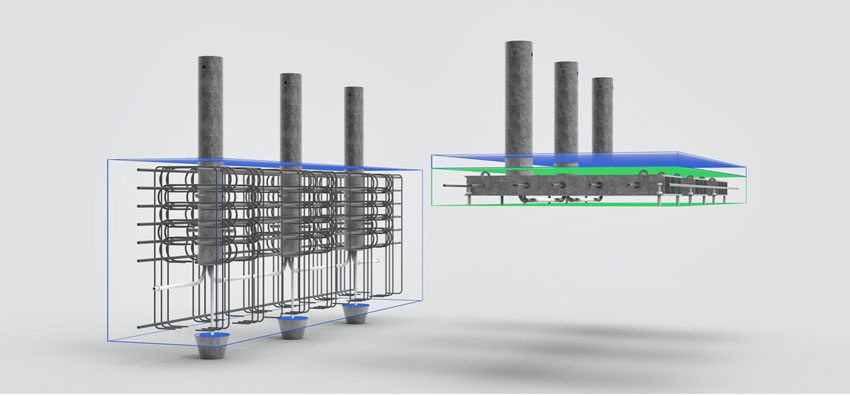
Photo courtesy of Forms+Surfaces
Deep mount versus shallow mount applications.
Foundation Engineering Overview
Bollard foundations may be either single or strip in design. A single bollard foundation is designed to support an individual bollard on its own and is tested for single impact to that bollard. A strip foundation provides a linked foundation for a row or set of bollards and is often engineered to provide additional or enhanced support. By linking the group of bollards, strip foundations can more evenly disburse potential impacts through the joined barrier and, therefore, can require a smaller foundation.
A foundation can be engineered in many different ways to meet the necessary standards.
“For effective performance of vehicle barriers, the foundation design must be able to support the loads acting on the barrier system.” (George Adom, An Innovative Foundation System for Bollards and Barriers) The projected impact loads and foundation design need to be calculated thoroughly to ascertain the correct design method to employ2. These impacts can be simulated, through tools like Finite Element Analysis (FEA) to test bollard strength and crash outcomes or can be achieved in a controlled setting at a testing facility. When studying testing results or simulations on a security bollard and its foundation, the engineering team is looking to confirm whether the core is going to deform and whether it has the potential to rip out of the ground. The performance of the foundation, including its integrity and disbursement of load, can be viewed. Using FEA analysis, potential security bollard core and foundation combinations can be assessed in a variety of scenarios. After these simulations are run, the results are studied to ensure that all engineering criteria are satisfied for adequate product performance.
Deep Set Foundations
Deep set or fixed foundations are the traditionally recognized method for constructing a foundation for a bollard with a security core. In this method, the security core is buried and set deep in the ground, at an approved depth, and anchored to an engineered foundation. Fixed bollards using in-ground pipe mounting methods may require a deep rebar supported concrete foundation.
The correct depth and width of the footer fluctuates depending on security requirements, soil conditions, and the desired mounting method. Specifications can be selected to meet a specific site requirement, balanced by the limitations of the depth and space allotted for the installation. It is important to find a manufacturer or supplier who can provide guidance and proper support documents to meet the varied needs of the site. These details will change depending on the rating desired and the bollard selected.
A standard deep set installation procedure for a single security bollard, utilizing a security core, begins with creating space for the foundation. A sufficient foundation size depends on soil, frost, and other conditions to be determined by the installer. The foundation is then prepared, and the security core is positioned, based upon foundation detail drawings and specifications required to support the desired security rating. The proper elements of bollard foundation installation should be advised by a licensed professional.

Photo courtesy of Forms+Surfaces
Today’s security bollards offer a huge aesthetic leap forward from generic pipes and cylinders.
Shallow-Mount Foundations
Shallow mount bollards were originally designed to combat the challenges of installing traditional security bollards, which require significant depth for their foundations. In some cases, the required depth isn’t an option—for example, in instances where utilities and/or other building services are exposed.
While installation of a traditional bollard involves burying a core deep within a prepared foundation, shallow-mount bollards are usually mounted on a plate or biscuit, which may be installed in a single configuration, or in a strip connected to other bollards for additional support. The shallow-mount plate is engineered to take the load from impact and provide required support for the bollard core. Using this method, shallow mounts for security bollards require just a fraction of the depth normally needed to generate the required support for a deep-set security bollard.
While shallow-mount bollards may come with a greater initial cost, they require a fraction of the contractor fees and installation costs of deep-set applications, making them a great alternative for installation where there is limited depth. Example applications include security bollards placed in parking garages, where mounting must take place within a shallow depth, and in areas where utility lines are buried closer to the surface.
Removable Bollards
Fixed bollards are the right choice for a location that a car should never enter, but there are other circumstances where bollards need to provide more flexibility.
In buildings with minimal or variable security needs, it may be worth considering bollards that are removable. Removable bollards can be moved or shifted as necessary, and offer better flexibility and access for maintenance and operations. For example, a strip of bollards may be needed to provide protection in front of a pedestrian door, but those bollards also have to provide the flexibility to be removed for site maintenance and to accommodate the occasional larger vehicle for loading. Bollards that bolt to base plates and can be removed or shifted as needed may provide an answer for these light security areas needing flexibility of the perimeter. It is important to note, though, that making a bollard removable often impacts its security rating; in many cases, removable bollards don’t meet designated security standards.
Bollard Spacing
The vehicle aperture describes the spacing between bollards that prevents vehicle clearance. Typically, the distance between security bollards is set at 40-inch minimum up to a 60-inch maximum, center-to-center, depending on foundation design variables. The desired security rating and bollard type may dictate a more exact and appropriate spacing. It is a common misconception that the ASTM standards dictate the spacing of the bollards, when in fact it is simply ensuring that bollards are spaced in a way that a vehicle has to contact one without passing through unimpeded.
Some vendors may base their ratings of impact on more than one bollard, which directly affects the spacing necessary to meet a standard. A designer should always check to make sure that any rated product is engineered so that one bollard alone will meet the impact criteria. Otherwise, design choices become extremely limited.
ELEGANCE AND RESILIENCE: DESIGNS THAT PERFORM
Security bollards offer robust protection for public spaces of all kinds. However, historically, most security bollards have taken the form of generic pipes and cylinders that offer little in the way of design or lighting functionality. Contemporary security bollards can do both: provide required levels of performance in combination with design and material selection that are aesthetically pleasing and integrate seamlessly into the design of a landscape. New design options make it easy to carry a cohesive look across a property while addressing different lighting and security needs. Leading manufactures are now offering, pathway bollards, pedestrian lighting, and exterior fixtures such as benches and trash receptacles to complement security bollards. By considering products in complementary materials, and designs, landscape architects or engineers can develop a holistic scheme that adds beauty and practicality to the site. By adding a fully tested security core to bollards, leading manufacturers are able to capture the best of both worlds, meeting stringent high-impact crash requirements while providing a beautiful and efficient bollard, with or without illumination. Selecting materials and finishes is integral to specifying site furniture products. Yet, making material selections is complex, as the need for security has joined more traditional selection criteria like aesthetics, durability, and performance. Today’s architects and designers are responsible for recommending materials that balance these different requirements.
Bollard Material and Finish Options
For security bollard designs, the opportunity to customize materials and lighting has vastly expanded. Function no longer has to happen at the expense of good design. Stainless steel and aluminum enclosures now play host to a variety of finishes and styles. Stainless steel is an excellent choice of material for bollards because of its strength, corrosion resistance, recyclability, ease of maintenance and aesthetic appearance.
Stainless steel bollards can be left with a satin finish or can be powdercoated to achieve limitless color possibilities. Powdercoat colors comprise a full palette of standard and custom options. Top manufacturers offer powdercoat colors that have been formulated to be ultra-durable for improved long-term wear and resistance to weather and are anti-graffiti, allowing marks from paint, permanent markers, and dirt to be removed easily, without harsh cleaners.
Additionally, select manufacturers can provide stainless steel surfaces treated with an invisible protective treatment that offers significantly enhanced protection from weather and graffiti and increases the maintenance ease of metal surfaces. This specialized surface treatment combines exceptional durability with the ability to lock out water spots, fingerprints, graffiti, and other surface damage. Treated surfaces are more easily cleaned and durable, as the treated materials are abrasion and scratch-resistant. The treatment is permanent, environmentally responsible, UV stable, and will not degrade or discolor over time.
Sustainability Through Durability
One of the best ways to eliminate what is added to a landfill and reduce a site’s carbon footprint is to specify products that are durable. Bollards from leading manufacturers are produced from stainless steel and aluminum and are carefully crafted to not only endure the elements, but to transcend temporary style trends. Using metals allows for a high degree of recycled content in the bollard product as well as recyclability of the product at its end of life.
Leading manufacturers provide Product Environmental Data Sheets that provide transparency and open reporting for all materials and products. This enables better and more sustainable product selection.
Illumination
Illuminated security bollards enhance and coordinate with pedestrian and landscape lighting fixtures, creating a seamless flow for exterior design. Not only do illuminated security bollards provide protection, but they also offer the supplementary benefits of pathway lighting and wayfinding for pedestrians. Additional lighting also bolsters building security.
Depending on design, illuminated bollards can provide symmetrical or asymmetrical lighting patterns and are available with LED light engines and in a variety of lamp temperatures from warm to neutral.
Lamp choice can provide enhanced energy efficiency. Symmetrical lighting patterns can be provided through coordinating bollard design. Bollards providing downward-facing light help minimize light pollution and glare. Lamp drivers can offer reverse-phase, forward-phase, and dimming capabilities. It is important to verify that lighting has earned the necessary certifications, including Class 2 rated output (UL8750) for LED lamps.
Design Options and Customization
For lit security bollards the design possibilities are numerous. Shields are available in symmetrical or asymmetrical configurations with standard or custom designs, offering multiple ways to direct light. Designs can include decorative perforation patterns, mesh, and shaped configurations. Custom capabilities are also available, so that names and logos can be incorporated into the shield surface, creating limitless opportunities for branding or wayfinding.
Manufacturer Support
Finding the right manufacturer is essential to creating a result that fits both the project space and security needs. There are numerous other considerations tied to site conditions that may come into play, including the necessity of installation under pavers, installation inside a parking garage, or in a setting that requires the bollard to be removable. A manufacturer that provides clear information regarding testing and certification is critical to ensure that you can trust the quality and performance of a security bollard product. The best manufacturer will act as both a supplier and a partner on a project.
CONCLUSION
Modern security bollards are a beautiful way to guard against vehicle infringement while allowing pedestrian access. Beyond updates making security bollards perform to the highest expectation, design improvements are allowing these security products to be tailored to site-specific needs, both in performance and aesthetic. As functional as they are beautiful, today’s security bollards are designed to protect as intended, and look good while doing it. Whether used in a streetscape, park, or surrounding a building exterior, sleek aesthetics are an attractive match for today’s security-conscious settings
END NOTES
1Impact Testing of Vehicle Security Barriers: An overview of vehicle impact test standards., Centre for the Protection of National Infrastructure (CPNI). August 2020.
2An Innovative Foundation System for Bollards and Barriers, by George Adom A thesis submitted to the Faculty of Graduate and Postdoctoral Affairs in partial fulfillment of the requirements for the degree of Master of Applied Science in Civil Engineering Carleton University Ottawa, Ontario © 2015, George Adom.
Amanda Voss, MPP, is an author, editor, and policy analyst. Writing for multiple publications, she has also served as the managing editor for Energy Design Update




